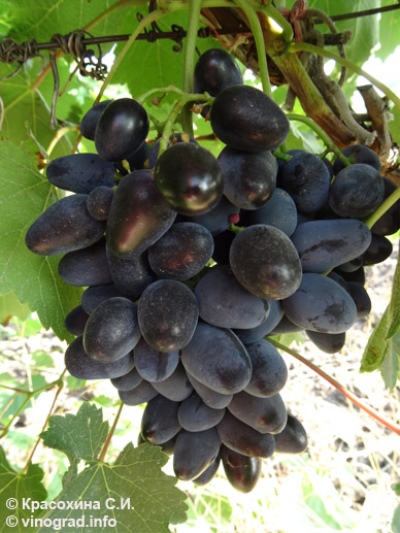
- Authors: Pavlovsky Evgeny Georgievich
- Appointment: dining room
- Berry color: black
- Taste: simple, harmonious
- Ripening period: early
- Frost resistance, ° C: -23
- Bunch weight, g: 600-800
- Flower type: bisexual
- Skin: thin
- Appeared when crossing: FVC-94-3 x Nadezhda AZOS
Carmen is a hybrid table grape form, bred by a complex interspecific crossing. The variety is famous for its attractive type of bunches, good taste, and is one of the first to harvest. The hybrid is widespread in the southern CIS countries and in regions with a subtropical climate in Russian latitudes.
Breeding history
The hybrid was obtained by amateur originator Pavlovsky Evgeny Georgievich by crossing FVC-94-3 and Nadezhda AZOS. Carmen belongs to the first generation of subspecies obtained by this author.
Description
The Carmen grape is vigorous, forms shrubs with a well and evenly ripening vine. It grows successfully in a self-rooted and grafted culture, gaining sufficient length and height of shoots (up to 2 m), abundantly forming green foliage. Flowering occurs in early May. Cuttings root easily and are used as the main breeding method. There are no signs of peas in the berries.
Ripening period
In terms of technical ripeness, the hybrid is usually referred to as early. Harvesting begins in the second decade of August. Technical ripeness is reached in 100-110 days.
Bunches
Dense conical clusters weighing 600-800 g are formed on the bushes.
Berries
The large size of the berries is characteristic - the weight of each reaches 6-8 g, their unusual shape, oval, elongated, pointed, attracts attention to the Carmen grapes. The black skin is always thin, underneath is a dense crunchy flesh.
Taste
The fruits of the hybrid have a simple harmonious taste, the sugar content in them reaches 200 g / dm3.
Yield
Abundant formation of ovaries requires the removal of excess ovaries from the bush at the fruiting stage. In the absence of rationing, the ripening periods are stretched, the berries gain sugar worse. The hybrid form is considered high-yielding, yields up to 5-6 kg of fruit per bush.


Growing features
This hybrid form is grown using standard agricultural techniques. Provides control over the formation of vines, regular mulching of the soil surface with preliminary weeding. During the ripeness period, watering is excluded, otherwise the fruits will be watery.
Landing
When choosing a landing site, you must focus on the southern or southwestern part of the site, which has an artificial shelter from the wind in the form of a building, a fence. Plants must be placed directly in the sun, without shading. They maintain a distance of 3 m from the nearest trees, 1 m from buildings. The best soil is sandy loam, loam, swampy, waterlogged soils are categorically unsuitable.
The time for planting is spring. The soil should warm up to +10 degrees and above.Since autumn, organic fertilizers are laid in the ground during digging. In the spring, a pit 70 × 70 × 70 cm is formed at the chosen place, it is refreshed with a layer of organic matter sprinkled with earth. When planting a Carmen hybrid, the root collar is not buried.

Pollination
No special pollination tasks are required. The hybrid has bisexual flowers that provide sufficient intensity of ovary formation.
Pruning
When rationing the load for this variety, it is recommended to withstand pruning of 34-36 eyes per bush. On fruiting vines, no more than 7-8 are left.



Frost resistance and the need for shelter
The vine can withstand a drop in air temperature to -23 degrees. In regions with cold winters with little snow, the formation of a shelter is mandatory.

Diseases and pests
The hybrid form demonstrates resistance to fungal diseases at the level of 3.5 points, to gray rot by 3 points (tolerance), and resistance to mildew and mildew is lower (2 points). In general, with proper agricultural technology and good care, most problems can be avoided. It is recommended to spray the bushes on the leaf with a Bordeaux mixture to prevent anthracnose; you will also have to fight phylloxera with the help of insecticides.

If a grape is exposed to any disease or insect, this always affects its appearance.
Storage
The bunches must be removed from the bush upon reaching technical ripeness. When left on the vine, they begin to wither.
Review overview
According to amateur winegrowers, Carmen can be considered a promising non-commercial hybrid for growing on a private farm. They note the abundant fruiting of the bushes, which requires mandatory rationing, the beautiful shape and piquant taste of the berries, while the sugar set is rather slow. Pavlovsky's hybrids already have a formed group of admirers. Most of them have several such forms of grapes on their site at once. This particular hybrid successfully takes root almost everywhere - from Kursk to Krasnodar, without causing trouble.
The obvious disadvantages of Carmen grapes include cracking of berries, which occurs on some types of soil - plants are very sensitive to the choice of location. In addition, the brushes are easily affected by rot; it is also impossible to overexpose the crop on the bushes. Low resistance to mildew makes the hybrid more vulnerable to this disease than other varieties.











































































